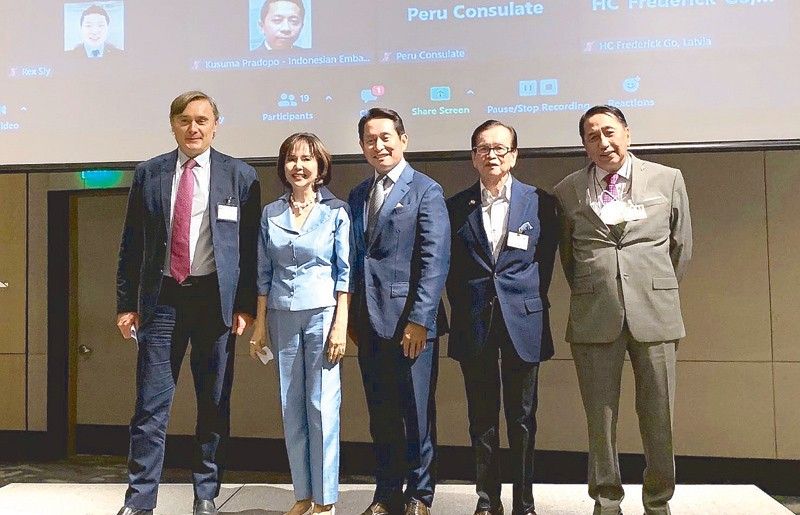The Philippine mining industry: Looking for a stable business environment

I was recently invited to speak at the third monthly meeting of the Consular Corps of the Philippines at the Conrad Manila. I thank Sergio Ortiz-Luis, Jr., Consul General to Romania and Dean of the Consular Corps of the Philippines, and Jesus Pineda Jr., Honorary Consul to Fiji, for the invitation.
In my speech, I tackled the state of the mining industry and what the industry hoped for, especially with the coming administration. Let me reproduce and paraphrase some parts of it here:
Mining, especially for a country that is as rich in mineral resources as the Philippines, has a tremendous potential to contribute to socio-economic growth. The Philippines has been ranked as the fifth most mineralized country in the world with untapped reserves estimated at $1 trillion. That is nearly three times the country’s GDP in 2021. In terms of global prospectivity, Philippine mining ranks third in gold, fourth in copper, fifth in nickel, and sixth in chromite.
In the 1980s, Philippine mining’s contribution to the economy was on the right trajectory vis-à-vis its mineral potential. Our country was the fourth largest producer of gold, copper, and nickel worldwide, with mining accounting for — at its peak — 21 percent of the country’s export earnings. Mining’s contribution to GDP reached 2.16 percent in 1985.
By the year 2000, mining’s contribution to GDP declined drastically by half to 1.1 percent due to several factors that started in the late ’80s. In 2004, the Supreme Court finally resolved the constitutionality issue against the Philippine Mining Act and mining reopened for business, with strong government policy support for the industry’s revitalization.
In a nutshell, mining took several big hits in a span of nearly two decades in the form of policy roadblocks, near-arbitrary closure and suspension orders, and a new tax rate that made the mining fiscal regime among the highest in world. Consequently, mining’s contribution to total exports plummeted to just 7.87 percent in 2020. Mining’s contribution to GDP, meanwhile, dropped to 0.6 percent that same year.

Over the last four years, however, mining’s share in the country’s total exports has seen a gradual increase — from 5.87 percent in 2018 to nearly eight percent in the first three quarters of 2021.
It ironically took a pandemic for the importance of mining to be recognized. This explains why mineral exports were largely unaffected and employment in mining was generally stable. Mining companies were able to donate over P380 million, or about $ 8 million, to the government’s fight against COVID-19.
In April 2021, we saw the lifting of the moratorium on new mining projects and, in December, the lifting of the open pit mining ban. These are most welcome developments indeed. Verily, the government needs all the help it can get in these uncertain times.
Three large projects that were stymied by the policy roadblocks are now in a better position to proceed to development. Collectively these copper-gold projects, all in Mindanao, namely, Silangan, Tampakan, and King King, can increase yearly national government revenues by P12 billion a year, local gov’t revenues by P1.5 billion, exports by almost $2 billion, and social expenditures by close to P800 million per year.
When most other industries were separating employees and workers at the height of the pandemic, government figures indicate that employment in mining increased by 2,000 to 184,000 in 2020, and by 12,000 to 196,000 in the first three quarters of 2021. These figures do not reflect the multiplier effect of four to five jobs created for every employee hired directly by the industry.
As of December 2021, the industry has spent over P26 billion for social development, nearly P385 billion in environmental protection and enhancement, and some P6 billion in final mine rehabilitation. Mining companies have planted over 45 million seedlings in over 35,000 hectares of land — with a survival rate of over 90 percent.
A recent Yahoo article cited a newly released World Bank report, which forecast that the world would need more than three billion tons of minerals and metals to limit the rise in global temperature by two degrees by 2050. That’s more than three billion tons in raw materials for solar, wind, and battery storage. The International Monetary Fund, on the other hand, reported last December that the future demand for metals and minerals may well top the current global supply.
It is ironic indeed that the mining industry, dubbed in the article as “a pariah for ages due to its massive environmental impact… is about to turn into the one indispensable industry for the energy transition.”
Against this backdrop, ESG has anchored itself as a mainstream aspect of business and will remain top-of-mind in the boardroom for years to come. It has become central in terms of both attracting investors and holding a social license to operate.
The Chamber of Mines is determined to be a strong partner in nation building — one with a strong focus on social development, on minimizing the impact of our operations on the environment, and on ensuring a fair division of the economic and financial benefits of mining. But first, please allow us to flourish.
As we anticipate the changing of government in the next few months, we choose to be cautiously optimistic. The Philippines has a lot of catching up to do as an investment destination and we cannot afford to miss the promising windows of opportunity presented by the energy transition in response to Climate Change.
To help the industry realize its full potential and be a true partner as a huge socio-economic contributor, I have produced a short wish list. Let me enumerate them:
First, we wish the next government would further its roles as facilitator, partner, and demonstrator of ESG best practices in the mining sector.

Second, we wish the next government would continue encouraging increased transparency and reporting of ESG practices in mining. Our participation in the Extractive Industries Transparency Initiative, or EITI, allowed us to further demonstrate our commitment to the highest standards of transparency and accountability in business.
Third, for government to harmonize local and national laws to avoid conflicts on the ground. The Philippine Mining Act of 1995 is considered by many industry experts to be one of the most advanced mining laws.
And fourth, give mining and all other industries a stable business environment — one where policies are reliable, contracts and investments are protected, and the rules do not change midstream.
We pledge our support for government — whoever its next leader would be — as it acts as the bridge linking the business community on one hand and, as we have shown we can do, and local communities on the other.
- Latest





























